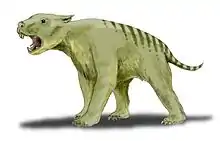Ilariidae
The Ilariidae is a family of fossil mammals. Most ilariids are found in the middle Tertiary faunal assemblages of South Australia. Ilaria illumidens is the best-preserved representative of this extinct clade of vombatiforms.
| Ilariidae | |
|---|---|
| Scientific classification | |
| Domain: | Eukaryota |
| Kingdom: | Animalia |
| Phylum: | Chordata |
| Class: | Mammalia |
| Infraclass: | Marsupialia |
| Order: | Diprotodontia |
| Infraorder: | Vombatomorphia |
| Family: | †Ilariidae Tedford & Woodburne, 1987 |
| Genera | |
The species is found in the Namba Formation of Late Oligocene age, at Lake Pinpa, South Australia. The material consists of a partial cranium and mandibular fragments with most of the dentition, together with parts of the postcranial skeleton.[1] The other species in this family are known from a few jaw fragments and intact molars attached; they are categorised in a separate family because their teeth structure is unique among Diprotodontia, in having a complicated folding pattern. Ilariids are thought to be the largest marsupials of their time in the Lake Eyre and Tarkarooloo basin.
References
- Patricia Vickers-Rich and Thomas Hewett Rich 1993 Wildlife of Gondwana Reed Books, Chatswood, New South Wales ISBN 0-7301-0315-3 Reed.
- http://www.tc.umn.edu/~jansa003/NSF/Fossils2.pdf accessed 2010-05-21

.jpg.webp)